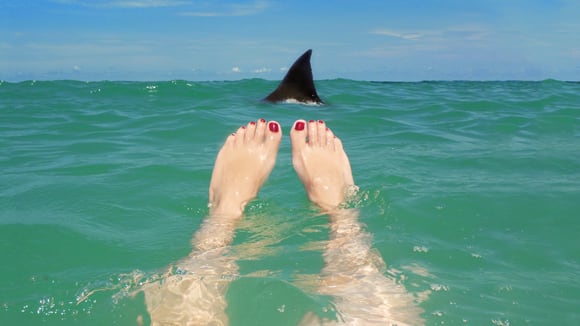Wade with caution
How to help a shark attack victim and avoid becoming one yourself.
Article Date:

The first thing Dustin Theobald felt was pressure. Then the rough skin of the shark’s brow.
He knew immediately that his fun day surfing with his 8-year-old son had taken a dangerous turn.
Theobald didn’t see much of the shark, just the tail. “I guess he didn’t like what he tasted because he let go,” he chuckled “Then, he went one way and I went the other!”
The Fernandina Beach resident hobbled to shore — the open wound on his foot a four-inch serrated gash from the shark’s bite. It wasn’t a terrible wound, thankfully, but what made it unusual was that, within just a matter of minutes, another individual was bitten by a shark just down the beach.
Before that afternoon, only four shark attacks had been recorded in Nassau County in the last 135 years — despite Florida being the shark attack capital of the world. While a majority of attacks occur on the Sunshine State’s southern shores, Duval County ranks fifth in the state for the total number of shark bites.
“I’ve never been bitten, and I don’t know anyone who has or anybody who knows anybody who has been bitten,” said Theobald, who was treated at both Baptist Medical Center Nassau and Baptist Medical Center Jacksonville. “You don’t want to be scared doing something you love. We know they are out there, but you just don’t think about it.”
But, there are easy tips you can follow to help a shark bite victim and avoid becoming one yourself.
Most shark bites tend to be hit-and-run, said Jeffrey Smowton, MD, chief of Emergency Medicine at Baptist Medical Center Beaches. Though it depends on the size of the wound and its location, the majority of bites can be addressed with direct pressure on the wound, he added.
Using clothing, towels or whatever you want to stem the blood flow helps the victim until emergency personnel arrives.
In extreme cases, the wound could require a tourniquet. However, Dr. Smowton says he’s been doing emergency medicine for years and has never seen a case that required one.
Call 911 immediately after getting the individual out of the water.
“Remember how rare this is,” Dr. Smowton said. “Everybody is scared in the moments after an attack – and I would be, too. But, 32 people a year die of lightning strikes. With shark bites, a person dies every other year.”
Unfortunately, there really isn’t a way to tell if a shark is present.
However, Jim Gelsleichter, PhD, University of North Florida Shark Biology Program director, recommends people exercise caution when swimming at dawn, dusk and nighttime when sharks are most active.
Even so, more people are bitten during the day because there are more people at the beach during daytime hours. Shiny objects like jewelry or even tattoos could attract a shark to an individual.
“There is strong evidence the odds for shark-related injuries are likely more related to human activity rather than increases in coastal shark activity,” Dr. Gelsleichter said. “Many scientists believe most shark bites occur as a result of mistaken identity — that the animals bite with the expectation they are feeding on prey.”
If you happen to be on the wrong side of a shark tasting, Dr. Gelsleichter has two words of advice: “FIGHT BACK!”
He suggests targeting the shark’s sensitive areas, such as the eyes, gills or snout. It is likely the shark will let go — a common occurrence in bites that happen off the Florida coast.
Most Florida bites are nonfatal, tending to be caused by smaller species such as the blacktip or spinner shark. “Sharks are there all the time,” Dr. Smowton said. “The bottom line is it is very unusual to be bitten by a shark. Most are accidental — a bump and bite. The shark tastes, and then he leaves. So, we don’t want to scare people out of getting into the water.”



